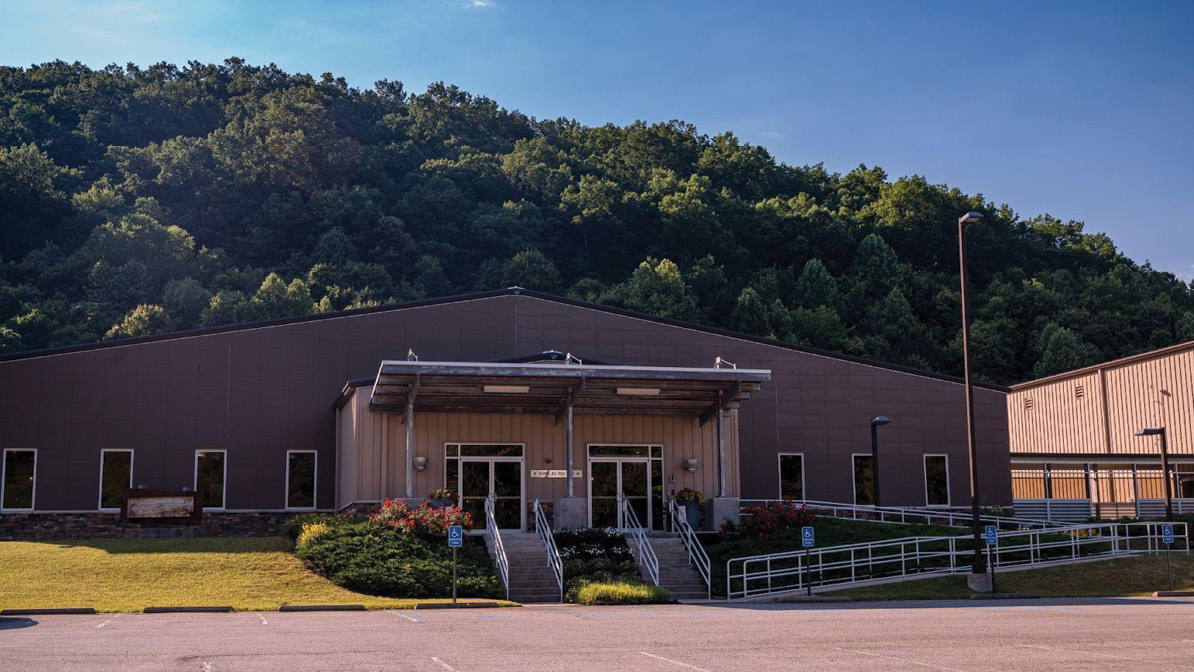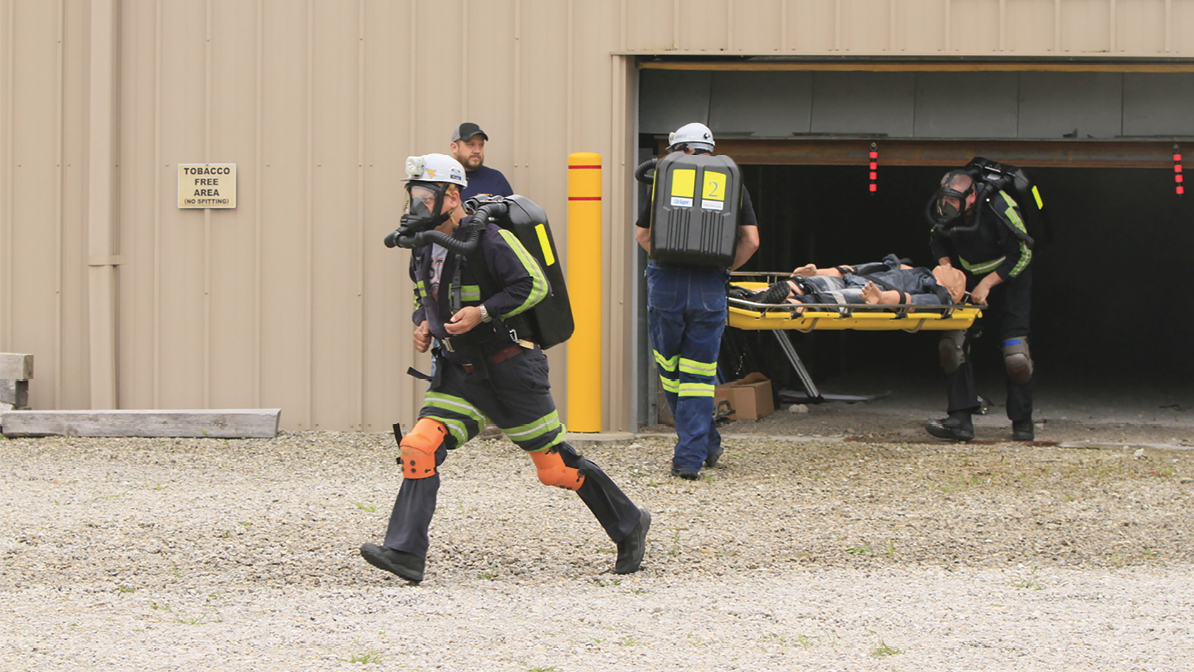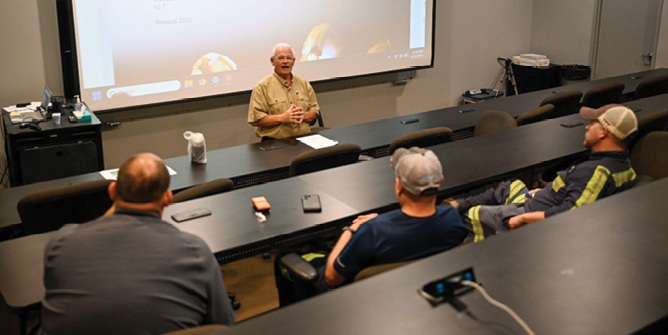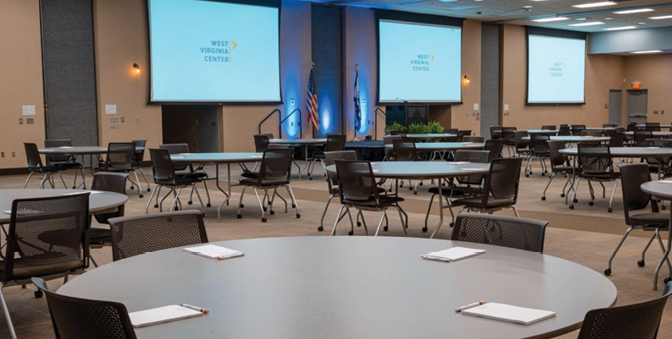The West Virginia Training and Conference Center sees thousands (24,000 in 2023) through its doors each year, each with the desire to elevate their skills with cutting-edge education and facility features. North American Mining magazine took a tour of this Appalachian coal country education gateway.
By Donna Schmidt

A group of miners are in the center of a mine emergency, offering first aid to a worker’s head in the dark amid heavy smoke while another miner lies nearby with a flesh wound to their leg. With time running out, the group picks up a gurney and the now-bandaged first aid recipient and they all emerge from the dark – into the sunlight and warmth of a fall day at the West Virginia Training and Conference Center, where the team had been competing in a regional mine rescue competition.
It is that real-life environment and scenario that makes this facility in Julian, Boone County, West Virginia, a top choice for mine rescue competitions, mine training courses, recertifications and many other events for miners from across the state and several neighboring states.
The facility, known also as the WVTCC, is operated by the West Virginia Office of Miners’ Health, Safety and Training (WVOMHST), which itself has been a part of the state’s industry since 1883, upon the passing of the first state mine safety act.
The WVTCC is as large as it is welcoming, with each entering individual seeing a sign reminding them to come as they are as they enter 140,000 square feet of opportunity to polish skills, learn new ones and share expertise with others.
The center was formerly known as the Running Right Leadership Academy, which was initially created after the April 2010 explosion that killed 29 at the Upper Big Branch operation in neighboring Raleigh County. It underwent a transformative change when it was acquired by the West Virginia Office of Miners Health Safety and Training in 2020, becoming the campus it is today.
The WVTCC is anything but small in impact or in physical presence; it is comprised of four substantial buildings. The first is the main building, which contains a large conference room featuring a garage door to display equipment for training, as well as private offices, a lunchroom and numerous classroom and conference spaces of various sizes, with its biggest seating 350 people.
“Building 1 features state-of-the-art audiovisual technology,” Facility Operations Director Kimberly Bradley said. “The on-site WV MHST Certification office streamlines certification issuance upon training completion, benefiting both students and employers. Additionally, the electrical labs, equipped with hands-on training stations, contribute to a consistent learning environment, evident in a recent 95% pass rate for apprentice electricians.”
Building 2 is the facility’s welding lab, equipped with 12 bays for mig (gas metal arc), tig (gas tungsten arc) and stick (shielded metal arc) welding. The space can be leased and also used for classes. At press time it was available, as its most recent tenant’s lease ended in 2023.
Building 3, the Mine Rescue Garage, houses emergency response vehicles and equipment, ensuring readiness for mining property incidents. Finally, Building 4 encompasses a Simulated Underground Mine Lab spanning 96,000 sq. ft., providing a realistic training environment stocked with authentic mining equipment.
“This venue serves as a vital resource for various types of training, including safety, operational management, maintenance, and first aid, primarily benefiting apprentice miners and mine rescue teams while supporting surface mining and fire safety training,” Bradley said.

WVOMHST Director Frank Foster added that operators like the facility because it is designed for a true training environment.
“Most use the classrooms/conference rooms set up as classrooms and electrical labs in support of the underground simulated mine lab to show real-life scenarios and to work on mining equipment,” he said.
Safety instructors are also available to offer training support, including teaching classes, obtaining certifications, or configuring the requested training environment.
“For example,” Foster noted, “[recently] we provided support to Arch Coal for their continuing education for their mine foreman [and have also] provided a venue for Coronado’s surface mining training and supported their SCSR training.”

The campus also plays host to 80-hour apprentice mining classes and has in the past provided support in the mine lab and instruction classes for Blackhawk Mining. Upcoming this spring: an EMT mining 60-hour class that it will host.
In all, Foster and Bradley report that 24,000 people entered the training center in 2023. For a building it initially paid $3 million for and has since invested $25 million, it is an immense source of pride for the facility’s staff as well as thosewho have been educated within its walls. In fact, Foster calledit a “pivotal resource for the coal industry” of the region. “[It was] designed to revolutionize mine training and elevate safety standards. The facility stands as an anchor in mine safety and represents a significant milestone in West Virginia’s efforts to lead the nation in coal mine safety,” he added.
“What truly sets this facility apart is its equipment and simulated mine, which provide mining professionals with a unique and highly realistic training experience,” Bradley pointed out. “The presence of cutting-edge technology and hands-on training opportunities ensures that individuals receive comprehensive instruction, equipping them with the skills and knowledge needed to excel in the mining field.”

Mastering mine rescue skills
The Fallen Heroes mine rescue event was held last September, with NAM on hand to see the teams compete and tour the WVTCC, which served as host for the contest, with Facility Operations Director Kimberly Bradley.
The Fallen Heroes Mine Rescue Event, hosted by the Central Appalachia Joseph A Holmes Safety Association in southern West Virginia, convened teams to showcase their expertise in various skill drills.
“When preparing for these competitions and fostering a safety culture, using a specialized training and conference center designed specifically for mine training is invaluable. The Fallen Heroes competition highlighted several different mine rescue skill drills,” Bradley said.
She covered the event as well for followers of the facility via the center’s blog series, offering some of the top skills and trainings used by the Fallen Heroes mine rescue crews that were made better because of the center’s capabilities.

Mine rescue skill drills: testing expertise and readiness
The Fallen Heroes event provides an unparalleled platform for mine rescue teams to showcase their skills and expertise in various challenging drills. These drills simulate real-life emergency scenarios, putting participants’ knowledge, teamwork, and problem-solving abilities to the test. Each drill allowed teams to demonstrate their readiness and effectiveness in critical situations, from exploring smoke-filled environments to performing rescue and first aid simulations.
Specialized training and conference center: the perfect learning environment
When preparing for mine rescue competitions and honing essential skills, using a dedicated training and conference center offers numerous advantages. A facility designed specifically for mine training ensures that the training environment closely mimics real-life mining conditions, enhancing the authenticity and effectiveness of the drills. The WVTCC is equipped with cutting-edge technology, a state-of-the-art underground simulated mine lab and specialized equipment, providing a comprehensive and immersive learning experience for mine rescue teams.
Realistic simulations and scenarios: building confidence and competence
One of the key benefits of a dedicated training center is the ability to recreate realistic mine rescue scenarios. The West Virginia Training and Conference Center provides controlled environments that closely replicate emergency conditions. By exposing teams to lifelike simulations, the WVTCC helps build confidence, refine decision-making skills, and improve the overall competence of mine rescue personnel. The hands-on experience in these environments prepares teams to respond effectively and swiftly during emergencies.
Collaboration and networking: learning from peers
The West Virginia Training and Conference Center is a hub for mine rescue teams from various organizations and regions. Participating in training and competitions fosters collaboration, encourages the exchange of knowledge and best practices, and allows teams to learn from their peers. Networking opportunities can not only expand professional connections but also contribute to the overall growth and development of mine rescue teams.

The 2023 Fallen Heroes Mine Rescue Event kicked off with a mine emergency response drill (MERD) at the West Virginia Training and Conference Center on September 11, 2023, and competition fields were hosted Sept.12-15 with an awards ceremony held on the 15th at Chief Logan State Park. The overall winner of the mine rescue event was the CONSOL Energy’s Bailey Blue Team.
